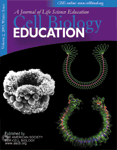Approaches to Biology Teaching and Learning: Science Teaching and Learning Across the School–University Divide—Cultivating Conversations through Scientist–Teacher Partnerships
Partnerships between members of the scientific community at institutes of higher education and the K–12 education community are an increasingly popular approach to science education reform (Atkin, 1989; Chatman, 2002; Sussman, 1993; NSF, 2003a, 2003b). Although the word partnership can mean many things to many people, we use the term scientist–teacher partnership here to mean a collaboration among a group of college or university scientists and K–12 teachers, with the goal of improving science education along the kindergarten through postgraduate educational continuum, although many other varieties of partnerships can and do exist through museum and industry collaborations. Since the inception of Cell Biology Education, we have used the space of this column to highlight pedagogical approaches or topics that could be useful to readers in reflecting on and improving their own teaching practice in biology education. We have explored a variety of science teaching issues, including the anatomy of the questions we ask our students (Allen, 2002), how we group students in the learning process (Tanner, 2003), the role of problem-based learning in developing higher-order thinking skills (Allen, 2003), and even the critical importance of simply how long we wait in the classroom to hear answers to questions (Tanner, 2002). We've attempted to provide resources and rationales that would be useful to the broad audience of readers, including those new and veteran to teaching, those who view teaching as their primary profession and those who combine teaching with scientific research or administration. In selecting topics and writing this column, it has been no small influence that the primary co-authors of this column function in two different professional realms of science teaching and learning, one predominantly focused on the undergraduate level and the other on K–12 classrooms. We have been engaged in our own partnership, of sorts, and thought it appropriate to highlight the potential role of partnerships between members of the K–12 community and the college and university communities as a promising avenue for improving the teaching practice of all of us in K–16 + classrooms. Indeed, we propose that partnerships across the divide between K–12 schools and institutions of higher education are essential in increasing the coherency of science education in the American educational system from the first days of kindergarten through the undergraduate years.
ISSUES IN EMBARKING ON SCIENTIST–TEACHER PARTNERSHIPS
Partnerships between scientists and teachers provide a flexible framework for collaboration between the K–12 community and institutions of higher education, and the proposed benefits of these scientist–teacher partnerships are enormous, including insight into the nature of scientific inquiry and deepened content knowledge for teachers, increased communication and teaching skills for scientists, and enriched science learning experiences for all students involved. Scientist–teacher partnerships can involve co-planning and co-teaching of science lessons in K–12 classrooms, professional development courses for novice teachers, and after-school academic enrichment for students; partnerships can also occur in scientific laboratories, engaging teachers in the culture of science and the doing of research. Although scientist–teacher partnerships have been emerging over the course of several decades, there has been an increasing attention to and funding of these efforts as an approach to science education reform. Most recently, in 2001 the federal government initiated the Mathematics and Science Partnership (MSP) awards, five-year competitive grants to promote partnerships primarily between colleges and universities and K–12 schools with the goal of improving students' performance in math and science (NSF, 2003b). An earlier effort, started in 1999, is the National Science Foundation's (NSF) Graduate Teaching Fellows in K–12 Education (GK–12) Program, which enables graduate students and advanced undergraduates in science, mathematics, engineering, and technology to support K–12 science and math education during their research training years by working directly in K–12 schools with teachers and students (NSF, 2003a). These awards provide generous stipends for GK–12 fellows and, thus, offer financial incentives for institutions of higher education to participate. Several National Research Council committees have reported ways to involve PhDs in K–12 science and mathematics education, and the NSF's PFSMETE Program offered postdoctoral fellowships in science education for recent PhDs in the sciences (NRC, 2000; NSF, 2003c).
As stated above, we are using the term scientist–teacher partnership here to mean any collaboration among a group of college or university scientists and K–12 science educators with the goal of improving science education at all educational levels, K–16+. In defining scientist–teacher partnerships, we are additionally using the term scientist to include all participants in the enterprise of science in higher education–not just faculty but also research associates, postdoctoral fellows, graduate students, and other trainees in the science and health professions. In many instances, scientist–teacher partnerships involve scientific trainees who are closer in age to K–12 students and who often have greater flexibility in their professional lives. By teacher, we refer to members of the K–12 teaching profession, including middle and high school science teachers, as well as kindergarten through fifth-grade teachers who teach elementary science along with many other core subjects. The inclusion of elementary school teachers in scientist–teacher partnerships is important because all national education reform documents assume the teaching of science during the elementary years, yet institutions of higher education may traditionally view only secondary school teachers as science teachers (NRC, 1996).
Unfortunately, although partnerships are easily proposed and even easily started, detailed knowledge of mechanisms to facilitate, support, and sustain these cross-institutional and cross-disciplinary partnerships is lacking and partnerships can be short-lived, achieving few of the widely proposed benefits. In our work facilitating scientist–teacher partnerships, we have encountered many potential barriers to collaboration and conversation among college and university scientists and K–12 educators (Chatman, 2002). Even the most well-intentioned and enthusiastic pioneers in a partnership may face challenges that arise independent of the particulars of their project, personal styles, and goals–challenges that are rooted in differences among the institutions (K–12 schools, colleges, and universities) and among the disciplines and professional practices of scientific research and K–12 education. In particular, scientists who are primarily engaged in research without significant responsibilities or experiences in science teaching may find the world of K–12 education foreign. Similarly, K–12 educators, elementary and middle school teachers in particular, may have little to no experience with the culture and content of the discipline of science. Although there are a growing number of scientists and teachers that have experiences in both the K–12 and the college and university worlds, we use the terms scientist and teacher herein to refer to those individuals with the least experience collaborating across these institutions, scientists whose primary focus is scientific research with little teaching experience, and teachers whose primary focus is teaching with little scientific research experience. In the spirit of generating productive partnerships and conversations between all teachers and scientists, we briefly highlight three issues that, when acknowledged and discussed among partners, may promote greater understanding among scientists and teachers, and when allowed to go unacknowledged can impede collaboration: (1) the importance of mutual learning in partnerships, (2) the professional cultures of scientists and K–12 educators, and (3) barriers of language in partnerships. Although the discussion of these issues is based predominantly on experiences at the Science and Health Education Partnership at the University of California, San Francisco, we anticipate that, in some form, they are relevant to partnerships at a variety of institutions across many disciplines.
The Importance of Mutual Learning in Partnerships
Not all collaborations among teachers and scientists involve mutual learning, a situation in which both parties contribute specialized expertise to a project and in turn learn from the expertise of their partner. In fact, many relationships between universities and K–12 schools and between scientists and K–12 teachers historically have been quite unidirectional, emphasizing the high status of institutions of higher education and the specialized content expertise of scientists, with little acknowledgement or regard for the expertise held by K–12 teachers, which ranges from pedagogical strategies and student cognitive development to a more broad scientific content background than many scientists possess. Perhaps as a result, some college and university scientists may view partnerships as primarily about fulfilling mandates from funders and useful in demonstrating community involvement to tenure and promotion committees. Contributing to this imbalance, K–12 teachers may view collaborations as primarily garnering resources for their students such as role models for certain scientific careers and speakers on particularly difficult content topics, rather than seeing scientists as colleagues who could contribute to their own professional development. Common profiles from the media and public opinion further these assumptions by emphasizing the failings of K–12 schools and teachers and the wisdom of universities, often neglecting to report the successes of the K–12 system and the failings of institutions of higher education.
That said, scientists and teachers have much to learn from one another about innovative pedagogical strategies, scientific inquiry, scientific concept development, student cognitive development, and recent developments in scientific understanding about how the natural world works. As such, a key issue in scientist–teacher partnerships is the extent to which these collaborations are characterized by mutual learning. Mutual learning requires that all participants in a partnership bring to their conversations and collaborations a learning stance, a willingness to be open to new ideas, a capacity to listen, and, most important, the professionalism to examine their own teaching beliefs and practices critically. The relative expertise each scientist or teacher brings to the partnership is dependent on his or her own depth and breadth of experience in teaching and scientific research. Therefore, in forging a partnership, it is key that both teachers and scientists ask themselves questions such as, “What is it that I want to learn?,” “What aspect of my own teaching do I need to improve?,” and “What scientific ideas or pedagogical skills could I explore with or learn from my partner?”
The Professional Cultures of Scientists and K–12 Educators: Common Ground
For scientists and teachers who come voluntarily to partnerships, one might assume that they have a great deal in common, including a passion for teaching, a commitment to reform, and a willingness to collaborate across institutional boundaries. However, whatever the intentions and motivations are of the individuals, there are larger professional and societal issues that play a role in partnerships as well. Each of us comes from a professional culture, a professional world distinct from our personal culture, established by the norms of our profession. As described by James Spradley, an educational researcher, “When ethnographers study other cultures, they must deal with three fundamental aspects of human experience: what people do, what people know, and the things people make and use. When each of these are learned and shared by members of some group, we speak of them as cultural behavior, cultural knowledge, and cultural artifacts” (Spradley, 1980, p. 5). Indeed, the professional cultures of science and K–12 education exist and can both help and hinder collaborations between teachers and scientists (Chatman, 1998, 1999).
The professional cultures of scientific research and K–12 education have commonalities that can be a source of familiarity for collaborating teachers and scientists, referred to herein as common ground (see Figure 1). Both teachers and scientists function in professions that are learning environments: for scientists, primarily learning about how the natural world works and for teachers, primarily learning about how students learn and how best to teach them. In addition, both teachers and scientists generally have tremendous passion for their field. Both professions require extremely long hours, although at different times of day with different constraints. Teachers and scientists often find commonality in that they must be prepared for the unexpected. Teachers speak of how s/he may be in the middle of a wonderful mathematics lesson when a butterfly emerges from a chrysalis in the terrarium, and s/he must reorient the class to take advantage of a teaching opportunity in science. Similarly, a scientist may be doing an experiment for one purpose, and if s/he doesn't look at the data point that is the outlier, s/he could miss an entire new stream of knowledge. Both professions are based on bodies of knowledge and research, and in each case, the connections between research and practical application–educational research and classroom pedagogy or basic biology research and clinical or other applications–are not always clear. In addition, the research knowledge base for science is generally both more publicly acknowledged and financially supported than it is for education. Last, both professional cultures experience mistrust by the general public on one hand, with issues related to genetically modified organisms, human cloning, and evolution, but then are expected to solve very complex problems, with a constant tension between the expectations of and the regulations imposed on both of the professions.
The Professional Cultures of Scientists and K–12 Educators: Uncommon Ground
While this common ground exists, the professional practices of scientific research and K–12 education also have differences that can be significant barriers to scientist-teacher partnerships (see Figure 2). We highlight a few of these issues of uncommon ground here (Chatman, 1998, 1999). Scientists, in general, have greater access to scientific resources than their K–12 counterparts, sometimes leading to unrealistic assumptions about what is available–running water in the classroom, electrical outlets–and thus what is possible while teaching in the K–12 setting. Similarly, teachers may overestimate the scientific knowledge held by their partner scientists, unaware of the extreme specialization required for success as a scientific researcher. As an example, a teacher may be surprised to learn that while his/her partner is the world's expert on the role of a specific protein in cell division, this scientist partner may be unable to spontaneously explain the structures and pathways of the human circulatory system to students, scientific content that is common knowledge for and used often by a secondary science teacher. In the context of co-planning and co-teaching lessons, scientists and teachers may also bring different levels of flexibility to their teaching styles. In the laboratory, scientists excel in the control of variables and the detailed planning of experiments, and even for scientists who are engaged in college or university teaching, their classroom setting can be a relatively staid and controlled environment compared with a lively middle school classroom. This is in contrast to the professional culture of education in which teachers are often in the position of responding to changing variables in the classroom and are more likely to be comfortable with a high level of improvisation in their teaching. Another point of uncommon ground is that scientists are often accustomed to functioning in an environment imbued with an intrinsic interest in science, whereas teachers are more often in the position of trying to cultivate interest on the part of students not only in science but also in other subjects that they may teach, especially at the elementary and middle school levels. Perhaps, the most salient of all the uncommon ground issues is that scientists are professionally trained to be critical in their pursuit of scientific research and teachers are professionally taught to be nurturing in the development of their students and supportive in interacting with one another. These cultural aspects of each profession result in scientists often communicating through skepticism and critical feedback and teachers often communicating through encouragement and positive feedback, using more tempered language. As one scientist volunteer at UCSF stated, “In science, if it's 98% effective, we're trained to pick apart the 2%,” to which a teacher laughingly responded, “And in education, if it's 45% effective, that's sure better than the 40% it was last year!” Not to be underestimated, this aspect of differences in professional culture, more than any other, can be a significant source of stress in scientist–teacher partnerships. Even for scientists who are equally involved in research and university teaching, the skeptical and critical communication style of the laboratory can permeate all of their professional communications. These differing approaches to communication can contribute to misinterpretations, such as scientists viewing teachers as complacent and uncritical about their work and teachers viewing scientists as unreasonable and never satisfied. Recognition of these communication differences and subsequent compromise, though, has the potential to bring new skills in communication to both teachers and scientists.
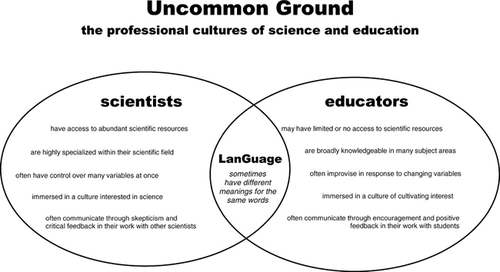
The common ground and uncommon ground ideas presented here are by no means exhaustive, nor will all of them apply to all teachers and scientists in all partnerships. However, the more that partners are aware of differences in each other's professional culture–its communication style, customs, values, and traditions–the more they can build a productive partnership, teach and learn from one another, and develop new knowledge and skills. An awareness of these issues of common and uncommon ground can remind partners that many of their differences are not personal but a reflection of their professional preparation, practice, and culture. In fact, insights gained through partnership into the similarities and differences in the professional cultures of science and education can lead to shifts in one's own professional identity and goals (Phillips, 2002; Tanner, 2000).
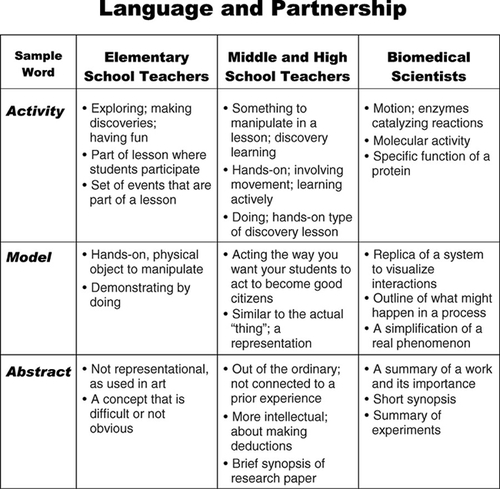
Barriers of Language in Partnerships
Communication can be challenging within institutions and disciplines. Even within the relatively focused field of biology, professional conversations among immunologists, neurobiologists, and cell biologists can be a struggle, with the practitioners of each subdiscipline steeped in their own vocabulary, nomenclature, and ways of knowing. When one brings together professionals across not only content boundaries but also, as described above, across the professional cultural boundaries of their disciplines, it is no surprise that language can quickly become a barrier. In addition to the more skeptical communication styles of scientists and the more encouraging communication styles of teachers described above, even phrases and single words can present challenges in partnership communication (Chatman, 2002).
Scientific terms such as basal ganglia and haploid mitosis are usually identifiable as specialized, and nonscientists recognize them as such and realize that they are unaware of their meaning. In contrast, terms in education are often composed of common words, for example cooperative learning or local systemic change or standards. These terms appear to be deceptively simple and cause the noneducator to attempt to derive the meaning simply as the sum of the conjoined terms. As an example, cooperative learning means much more than students helping one another during a lesson and is in fact a well-researched and complex pedagogical approach (Johnson et al., 1991, 1993). In addition, seemingly simple words like activity, model or matrix can have multiple meanings even within one field, but when definitions are compared among teachers and scientists, very different multiple meanings and uses of these words becomes apparent. Figure 3 shows a sample of definitions generated by participants in scientist–teacher partnerships for these terms, highlighting differences for three words commonly used in both scientific research and K–12 teaching. It is noteworthy that the definitions form a continuum of meaning, with some overlap between the two categories of teachers and some overlap between middle and high school teachers and biomedical scientists. In addition, the word model has been reported by some elementary school teachers to mean exemplary or best, as in “this has been designated a model school for how science should be taught,” adding a quality of superlative judgment to the word that would be unintended by a scientist proposing a “model lesson” for an upcoming classroom collaboration.
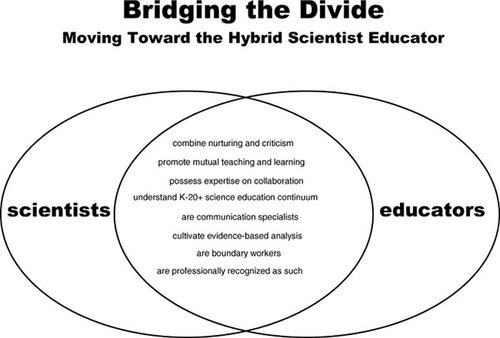
Even for words where there is a common definition, the connotations of those words may differ. In the field of science, the word training is common–scientists write training grants; they do postdoctoral training; senior scientists train graduate students in the practice of science–and is neutral in its connotation. In the field of education, the parallel term used in the preparation of teachers would be professional development, and for some K–12 educators, though certainly not all, the term teacher training may sound inappropriate or even pejorative. In response to a suggestion that middle school students be trained to use pipettes, a teacher once commented, “one trains dogs, not children.” By no means will all or even most teachers respond to the term training as strongly as this teacher did; however, it is an example of how culture and context inevitably color words and language. Similarly, words such as problem, development, theory, matrix, system, inquiry, fact, and variable can also contribute to language barriers and communication gaps. Because the pitfalls of language are innumerable, most important is a willingness among partners to be careful with language, to have a generosity of spirit in interpreting what is said, and to make a commitment to exploring and making explicit the meaning behind the words used in communicating.
BUILDING THE DISCIPLINE OF SCIENCE EDUCATION PARTNERSHIP
Although we have presented differences between the professional worlds and practices of scientific research and K–12 education, these distinctions are increasingly blurred by a growing number of professionals from both fields bridging the gap. Individuals, who come from a diversity of backgrounds, including K–12 teaching, undergraduate teaching, scientific research, science education, and informal education, are emerging as professional hybrids, as scientist educators, who have significant experience in both the professional cultures of scientific research and K–12 education (see Figure 4). Through their experiences in both realms, these individuals are able to cross the boundaries between colleges and universities and K–12 schools, bringing expertise in promoting collaboration and communication among scientists and teachers. With their cross-institutional knowledge and experience, these hybrid scientist educators are in a position to promote articulation and coherency along the K–16+ science education continuum as well as foster conversations among teachers of all levels about student-centered learning, key conceptual knowledge, and the role of inquiry in science learning.
Here, we have shared informally a few of the issues that have emerged in our work facilitating scientist–teacher partnerships. Because the potential benefits of these partnerships are enormous, detailed and extensive knowledge of how partnerships work and what scientists, teachers, and, ultimately, their students reap from them is essential. Unfortunately, few resources exist on how to facilitate and sustain scientist–teacher partnerships (Chatman, 2002; NRC, 2003; Sussman, 1993). The increased attention to partnerships as a mechanism for science education reform that could promote greater articulation between science teaching and learning at the K–12 and the college and university levels invites formal studies of scientist–teacher partnerships in these venues. Studies such as these would begin to build the discipline of science education partnership and inform future partnership projects and collaborations across a variety of institutions, content areas, and professional cultures. In closing, we encourage you, the reader–likely a scientist educator hybrid yourself–to help build the discipline of science education partnership by embarking on systematic studies of your own partnerships and sharing this scholarly work in journals such as Cell Biology Education.
ACKNOWLEDGMENTS
We wish to thank all staff members, past and present, at the Science and Health Education Partnership (SEP) of the University of California, San Francisco, for many thoughtful and inspirational conversations on scientist–teacher partnerships that contributed to these ideas. Liesl Chatman is the originator of the Venn diagrams featured in the figures included here.


